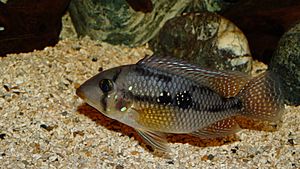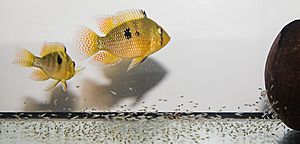Pearl cichlid facts for kids
Quick facts for kids Pearl cichlid |
|
|---|---|
 |
|
| Scientific classification |
The pearl cichlid (Geophagus brasiliensis) is a beautiful type of fish. It belongs to the cichlid family. These fish originally come from rivers and lakes in southeastern Brazil, Paraguay, Uruguay, and northeastern Argentina. You can also find them in slightly salty lagoons nearby.
Pearl cichlids have been moved to many other countries. These include the United States, Australia, the Philippines, and Taiwan. Many people who keep fish as a hobby, called aquarists, love to have pearl cichlids.
This fish is part of a group of similar species. These include other rare types like G. diamantinensis and G. iporangensis. Most of these related species are found in Brazil.
Contents
What Do Pearl Cichlids Look Like?
Male pearl cichlids can grow quite large. They can reach about 25 centimeters (10 inches) long. Females are usually smaller, growing to a bit more than half that size.
Their main body color can change. It might be light brown, dark blue, or even purple. Their colors can become brighter or duller depending on their mood. They also change colors during mating time.
Pearl cichlids often have one dark spot near their tail. They might also show several black stripes on their body. Their bodies are covered in bright blue speckles. These speckles shine brightly when the fish is healthy. Their fins are usually red. They might have blue tones and black tips. These fin colors can also change with their mood.
When kept in a group, pearl cichlids usually find a partner. This happens when they are about 5–8 centimeters (2–3 inches) long. At this time, they can become very protective. They will keep other fish away from their breeding area.
How Pearl Cichlids Reproduce
It can be hard to tell if a pearl cichlid is male or female. This is true until they grow to adult size. Once they are adults, the size difference between males and females becomes clear.
Fish breeders often try to pair them up without knowing their sex. Sometimes, two females might pair together. If this happens, they will lay eggs, but these eggs will never hatch.
Once a male and female pair is found, they can have many babies. A successful pair usually produces 150 to 200 young fish. Unlike some other fish species, pearl cichlids do not need to be separated from their young. They are good parents.
Where Pearl Cichlids Have Been Introduced
Pearl cichlids have been released into new places. In Australia, they are found in the Tweed River system in New South Wales. They also live in the Swan River system in Western Australia. These fish can live in both fresh and slightly salty water. They can also survive in water with different pH levels.
See also
 In Spanish: Geophagus brasiliensis para niños
In Spanish: Geophagus brasiliensis para niños




